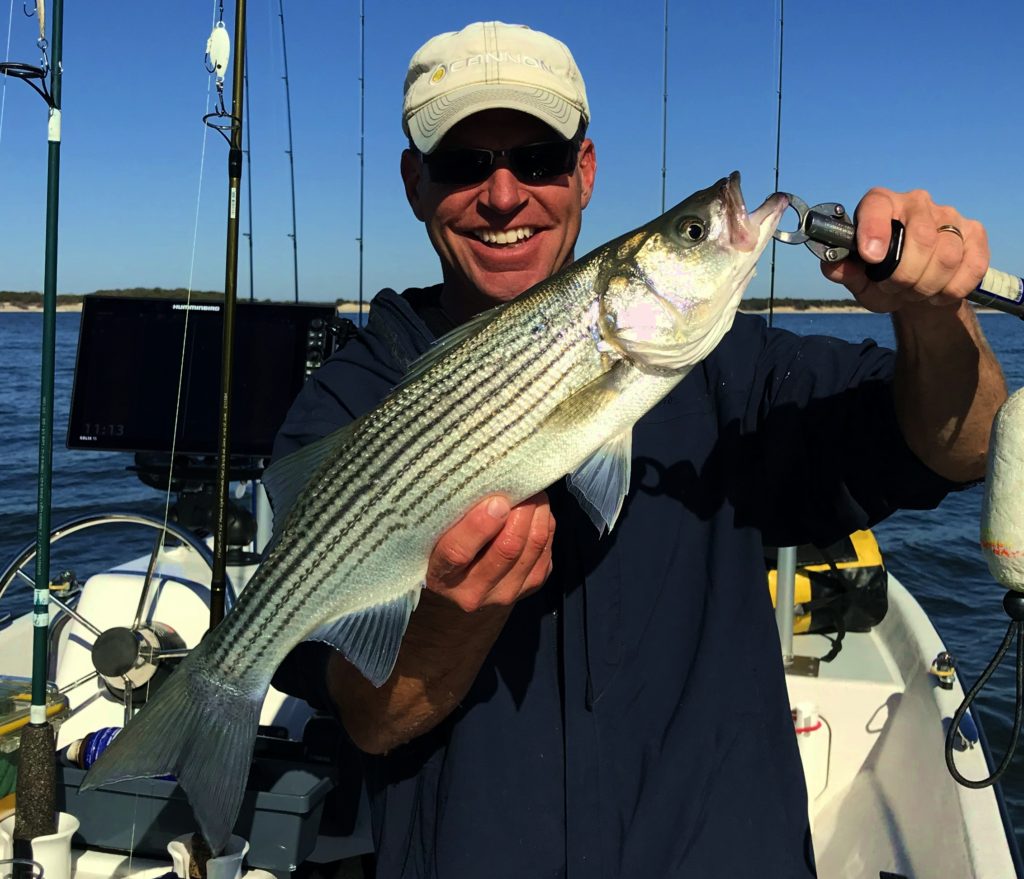The following is the text from my recent weekly column in the Killeen Daily Herald detailing a recent outing in which fellow guide Jason Weisberg and pursued striped bass on Lake Whitney on Dec. 13th…
As I meet and fish with folks from all over the nation (and, on occasion, some from other nations), I find it interesting how some are interested in catching great numbers of fish, regardless of size, while others prefer to hunt for fewer, but larger, fish.
Others focus on a particular style of fishing, while some focus on a particular species. Some anglers keep lists of their ‘personal bests,’ and some keep tabs on the variety of species they are able to tempt and land.
If you are an angler falling into this latter category and have yet to add the freshwater striped bass to your species list, this article is for you.

The cool months of the year at our latitude here in Central Texas tend to produce striped bass more readily than the warmer months do.
In fact, it is partly because of the freshwater striped bass’ inability to tolerate heat that fisheries biologists developed the hybrid striped bass by crossing striped bass with white bass to produce a fish more capable of tolerating the high water temperatures found in our nation’s southeastern and southwestern reservoirs.
Within a short drive of the Killeen area are two excellent striped bass lakes known for producing solid numbers of smaller fish up to 25 to 27 inches in length, which weigh 4 to 5 pounds.
To our north, just northwest of Waco, is Lake Whitney, a 23,500-acre reservoir on the Brazos River. To our west, just west of Burnet, is Lake Buchanan, a 22,200-acre reservoir on the Colorado River.
Both lakes are oriented generally north and south lengthwise with the main river channel flowing in from the north, and with their dams located on the southern ends.
I enjoyed a ‘guide’s day off’ trip to each lake over the past two weeks to sample the fishing for striped bass. On December 13, I was accompanied by fellow guide Jason Weisberg of Round Rock on a trip to Lake Whitney. The weather conditions were less than ideal with a 26-degree starting temperature before sunrise and nearly cloudless skies. We did have a southerly breeze at under 10 miles per hour, which was helpful.
On this trip we fished out of my custom-made Maritime 2090 equipped with a Minn Kota Ulterra trolling motor, Lowrance Carbon 16 sonar, and a Humminbird Solix 15 sonar.
In review, we caught 101 of our 106 fish by 11:15 a.m., despite staying though 3 p.m. continuing to search for additional catchable fish. We caught a mix of striped bass and white bass; Lake Whitney does not have hybrid striped bass.
Bird activity to the east side of the Brazos River channel at mid-lake helped us locate a majority of the fish we caught. Our best fish came on soft plastic swimbaits which were cast long distances and retrieved rapidly along the deep flats adjacent to the river channel in 25 to 30 feet of water.
More, but smaller, striped bass and white bass were taken with vertical tactics using slabs in the same areas.
Using the Spot Lock feature on the Ulterra was helpful in maintaining position over top of the fish we worked to find.
On Tuesday, I fished in cool, windless, rainy conditions on Lake Buchanan with Triton Boats and Texas Boat World pro staffer Ronnie Trower of Harker Heights. Although this day’s conditions were also less than ideal, we managed to put white bass, hybrid striped bass, freshwater striped bass, largemouth bass and spotted bass in the boat on this multispecies effort.
On this trip, we fished out of Trower’s new Triton 22TrX Elite bass boat equipped with Lowrance Carbon 12 sonar and a Minn Kota Ultrex trolling motor.
We found the largemouth bass and spotted bass in 10-16 feet on rocks, and the temperate bass (whites, stripers, and hybrid) near the river channel and under birds, just as they presented themselves at Whitney.
The largemouth and spots fell for Carolina-rigged soft plastics in dark, natural hues, whereas the temperate bass fell for shad-imitators including silver slabs, white slabs and shad-colored swimbaits.
Both vertical and horizontal retrieves fooled the stripers, hybrid and white bass. As is a standard practice on my boat anytime slabs are used, we rigged our slabs with Hazy Eye Stinger hooks.
Because of their size, both lakes harbor populations of gulls and terns year-round, but the most helpful bird activity typically takes place from November through early March.
If you go, allowing the weatherman to assist you is a wise move. Look for southeast, south or southwesterly breezes from 9-15 mph and abundant cloud cover. I have never encountered such conditions in the winter and not found the fish willing to bite.
A 90-minute drive and donning some warm clothing is all that stands between you and adding the freshwater striped bass to your species list.

